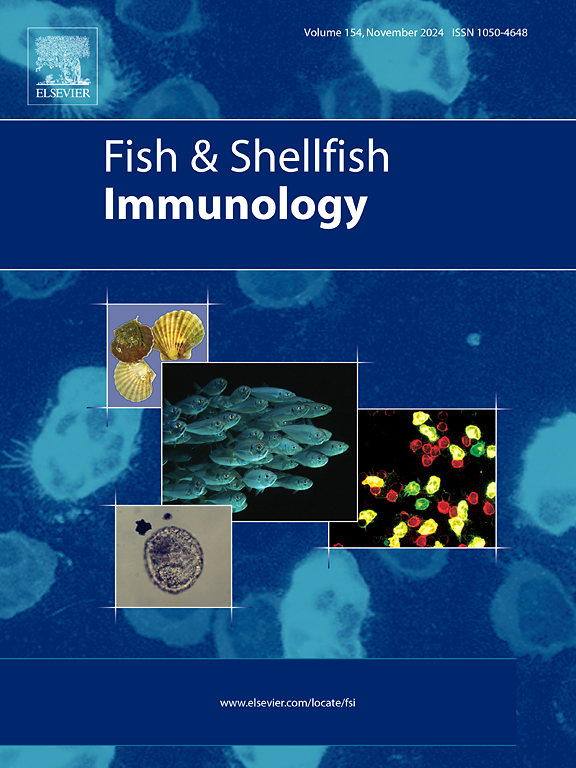A novel LPS binding /bactericidal permeability-increasing protein (LBP/BPI) from the scallop Argopecten purpuratus plays an essential role in host resistance to Vibrio infection
IF 4.1
2区 农林科学
Q1 FISHERIES
引用次数: 0
Abstract
Lipopolysaccharide binding proteins (LBPs) and bactericidal permeability increasing proteins (BPIs) play significant roles in the immune response of vertebrates against bacterial pathogens. These soluble proteins produced by immune cells, specifically interact with and bind to bacterial lipopolysaccharides (LPS), with BPIs also displaying antibacterial activity. In Argopecten purpuratus scallop larvae resistant to Vibrio bivalvicida VPAP30, we identified a significant overexpression of a transcript displaying molecular features of an LBP/BPI protein, both before and after infection. Therefore, in the present work we aimed to understand the role of this novel LBP/BPI, named ApLBP/BPI3, in the scallop resistance to this Vibrio. The ApLBP/BPI3 open reading frame encodes a putative protein of 506 amino acids, with a molecular weight 56.78 kDa. The protein contains a C-terminal domain of 403-amino acid that, after theorical cleavage, displays a soluble form of 44.99 kDa, featuring two BPI/LBP/CETP domains, an apolar binding pocket, a single disulfide bond and a BPI dimerization interface. Phylogenetic analysis reveals high similarity between ApLBP/BPI3 and other mollusk LBP/BPI proteins. Aplbp/bpi3 transcripts were constitutively and highly expressed in hemocytes, gills, mantle, and digestive gland tissues, and were induced following VPAP30 infection in scallop larvae and adult hemocytes. We characterized ApLBP/BPI3 protein using a polyclonal antibody against a synthetic peptide. ApLBP/BPI3 was secreted to the media by infected cultured hemocytes, detected by ELISA. ApLBP/BPI3 was spotted inside non-infected hemocytes, bound to the cell wall of V. bivalvicida after in vitro hemocyte infection, and coating the gills and mantle epithelial barriers before and after an in vivo immune challenge, with stronger detection after VPAP30 injection, detected by immunofluorescence. Infected scallop larvae showed increased ApLBP/BPI3 levels, with slightly higher production in resistant larvae, determined by Western blot. Finally, silencing the Aplbp/bpi3 transcript through RNA interference and and subsequently infecting scallop juveniles with an LD50 of V. bivalvicida resulted in 100 % mortality. Altogether, results demonstrate the essential role of this immune effector in the resistance of A. purpuratus.
扇贝中一种新型 LPS 结合蛋白/杀菌渗透性增加蛋白(LBP/BPI)在宿主抵抗弧菌感染的过程中发挥着重要作用。
脂多糖结合蛋白(LBPs)和杀菌渗透性增加蛋白(BPIs)在脊椎动物对细菌病原体的免疫反应中发挥着重要作用。这些由免疫细胞产生的可溶性蛋白能与细菌脂多糖(LPS)特异性地相互作用并结合,其中 BPIs 还具有抗菌活性。在对双瓣弧菌 VPAP30 具有抗性的紫扇贝幼体中,我们发现在感染前后都有一个转录本显著过表达,该转录本显示了 LBP/BPI 蛋白的分子特征。因此,在本研究中,我们旨在了解这种名为 ApLBP/BPI3 的新型 LBP/BPI 在扇贝对这种弧菌的抗性中的作用。ApLBP/BPI3 开放阅读框编码一个 506 个氨基酸的假定蛋白,分子量为 56.78 kDa。该蛋白含有一个 403 个氨基酸的 C 端结构域,经过理论裂解后,其可溶性形式为 44.99 kDa,具有两个 BPI/LBP/CETP 结构域、一个极性结合袋、一个二硫键和一个 BPI 二聚化界面。系统进化分析表明,ApLBP/BPI3 与其他软体动物的 LBP/BPI 蛋白具有高度相似性。Aplbp/bpi3 转录本在血球、鳃、套膜和消化腺组织中组成型高表达,并在扇贝幼体和成体血球感染 VPAP30 后被诱导表达。我们使用针对合成肽的多克隆抗体鉴定了 ApLBP/BPI3 蛋白。通过酶联免疫吸附法检测,ApLBP/BPI3 被感染的培养血细胞分泌到培养基中。在体内免疫挑战前后,ApLBP/BPI3 在未感染的血细胞内被发现,在体外血细胞感染后与双壳裂头蚴的细胞壁结合,并包被在鳃和套膜上皮屏障上,在注射 VPAP30 后检测更强,用免疫荧光法检测。受感染的扇贝幼体显示 ApLBP/BPI3 水平升高,通过 Western 印迹法测定,抗性幼体的 ApLBP/BPI3 产量略高。最后,通过 RNA 干扰沉默 Aplbp/bpi3 转录本,然后用半数致死剂量的双壳裂头蚴感染扇贝幼体,死亡率为 100%。总之,研究结果表明,这种免疫效应因子在紫扇贝的抗性中起着至关重要的作用。
本文章由计算机程序翻译,如有差异,请以英文原文为准。
求助全文
约1分钟内获得全文
求助全文
来源期刊

Fish & shellfish immunology
农林科学-海洋与淡水生物学
CiteScore
7.50
自引率
19.10%
发文量
750
审稿时长
68 days
期刊介绍:
Fish and Shellfish Immunology rapidly publishes high-quality, peer-refereed contributions in the expanding fields of fish and shellfish immunology. It presents studies on the basic mechanisms of both the specific and non-specific defense systems, the cells, tissues, and humoral factors involved, their dependence on environmental and intrinsic factors, response to pathogens, response to vaccination, and applied studies on the development of specific vaccines for use in the aquaculture industry.
 求助内容:
求助内容: 应助结果提醒方式:
应助结果提醒方式:


